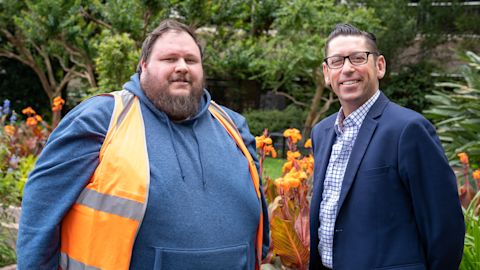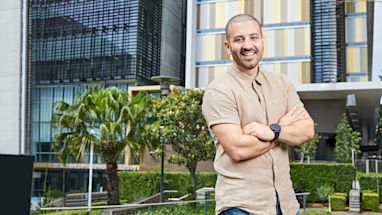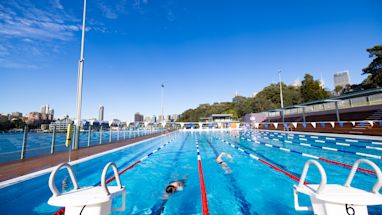This is how 2 teams from very different parts of the City of Sydney came together to preserve Sydney Park’s famous brick kilns.
Glenn Merry, specialist project manager from City Projects and Property and Shane Knight, maintenance coordinator for City Infrastructure and Traffic Operations, work in very different parts of the organisation.
But an important project aimed at preserving some of Sydney’s industrial heritage brought them together for a week of discovery, camaraderie and a lot of mud.
A familiar piece of inner-west skyline
Glenn: You can’t miss the brick kilns in the north-west corner of Sydney Park – they’re a well-known feature in that part of town. They’ve existed on the site for over 150 years.
There are rich deposits of clay in the area, so the brickmaking industry established works there in the early 19th century and that continued until the 1940s.

Given the age and condition of the kilns, we need to do significant stabilisation and restoration works to help preserve them. The works will also include landscape renewal around the brick kilns area which will help to interpret and reflect the previous industry on the site.
The incredible design work being done by design manager Max Rosin Melser, landscape design manager Lisa Dodd and the design consultancy team will result in a welcoming space that our communities can enjoy.
The restored kilns are at its heart, but there’ll also be an interpretation of other heritage features that no longer exist on the site, like the processing plant, the rail tracks used to transport materials from the vast pit and some of the lost kiln structures.
Shane: The structures aren’t going to be used as anything else, which I think is a good thing. These structures are so impressive and keeping them preserved also keeps part of Sydney’s history alive.
Being out onsite, I realised how much the park is enjoyed by the public. There are families out and about, running clubs, people walking their dogs. It was nice to have lots of people coming to chat to us about what we were doing and being interested in the work.
An extraordinary dig
Glenn: One of the challenges of the project is that we have limited plans or drawings of the existing structures on the site to help guide us. This limits our understanding of the foundations and footings or their current condition.
We needed more information to better understand the construction detail and help us with our design going forward.
That meant we needed to dig! The excavation work became essential. It was a big job, and one that needed to be handled with a lot of care and patience.
The excavation needed to be undertaken according to the instructions and guidance of Max, an archaeologist, structural engineers, heritage architects and other consultancies who were monitoring the works and the findings.
It turned out to be a wonderful opportunity to utilise the skills and experience of teams within our organisation.

Shane: When I was approached about doing the excavation work, I was keen to be involved. The whole team was because it sounded so interesting.
We're going to be part of keeping history alive, and that's exciting for us. My guys were coming from fixing potholes to being part of something extraordinary. It meant a lot to be asked to be involved.
Glenn: The enthusiasm from the team was pivotal to the success of the work. You could see the excitement, and it was reflected in the care that they took every single day of that week to make sure it was done right.
The methodology Shane and his team used was so important because it didn’t put any stress on the structures, which was exactly what we wanted. They were extremely vigilant.
Shane: The team were like Energizer bunnies - they just wanted to keep digging. It was exciting because we had no idea what we were going to find.
Buried treasure
Shane: Every day on the dig was different. It was such a great experience because we were working with different professions each day. The team is used to working in small groups of 2 or 3 usually, so it was great to interact with everyone.
There was an archaeologist and a structural engineer onsite. Glenn, Max and their team were down there a lot because it was such a good atmosphere.
Glenn: It’s true! We couldn’t stay away. The original plan was just to brief the guys and return for periodic inspections of the pits as they were excavated. But it turned out there was so much value in being there for observation and documentation.
We learnt that so many of the assumptions held prior to the excavation of the test pits turned out to be wrong.
Shane: Whenever we found something, the whole team would run over to see what it was. There was one day when we found a whole chimney flue we didn’t know would be there. It wasn’t on any of the maps we had. It was an intact chamber buried next to a chimney stack.
Glenn: The original brickwork in the chamber was in great condition, with the beautiful arches framing the flues intact. We’re so lucky we found it, and that it was preserved so well. You wouldn’t see underground structures of this nature built like this anymore.
Shane: It was a challenge. For example, the chimney flues and chambers aren’t waterproof, so they had filled with groundwater over the decades. Once we’d uncovered it, the groundwater in the flues filled the chamber, which made it hard to investigate.
We had to get another crew from City Infrastructure and Traffic Operations in to help with the removal of the water from the chamber. There was a lot of mud!
Glenn: But we overcame it, and that’s what it's all about. It’s an ongoing process of discovery and reaction.

Putting people first
Shane: There were other sensitive issues we had to consider, and this is another example of collaborating with other teams too. We were told by the Homelessness unit that a rough sleeper lived right by the area we were digging in, a gentleman called Pete. With its help, we were able to let Pete know we were coming and keep the interruption to his space to a minimum.
Glenn: The Homelessness unit have given us a lot of support during our site investigation works to manage that situation, especially how to make Pete feel comfortable about us being there. How to manage his expectations about what would be happening.
There was a lot of respect on both sides.
Shane: He was a real character and chatted to us most days. I was proud of the consideration the team showed him. The boys bought him breakfast in the mornings, and we enjoyed his company.
Time to shine
Glenn: At the end of the day, we have such a great and diverse range of skills and services that can be provided across the organisation. Sometimes we get tunnel vision working within our own teams and divisions, but through collaboration and cooperation we can achieve incredible outcomes for our communities with the amazing skills we have.
Shane: The support from Glenn, Max and the team was fantastic – any time we needed them they were there. Everyone got along really well, you could see we were all enjoying working together on this. For my team, it’s an important way to showcase the work we can do and the skills we have.
The team is always learning new things, but it's also so important for them to see what they are capable of.
They were able to walk away each day with their heads held high, and they were genuinely excited to come back the next day. Hopefully we’ll be considered to do it again in the future – we’re ready to go anytime!
At the end of the day, we have such a great and diverse range of skills and services that can be provided across the organisation... through collaboration and cooperation, we can achieve incredible outcomes for our communities.
— Glenn Merry
Published 10 December 2022, updated 14 October 2024



